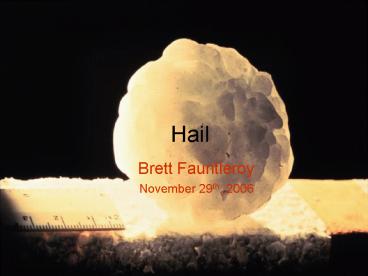Hail - PowerPoint PPT Presentation
1 / 16
Title:
Hail
Description:
... in size as it collides with super-cooler raindrops and other small pieces of hail. ... morning of May 20, 2006 a stable front spread from Oklahoma east to ... – PowerPoint PPT presentation
Number of Views:261
Avg rating:3.0/5.0
Title: Hail
1
Hail
Brett Fauntleroy November 29th, 2006
2
Hail - Definition
- Hail is precipitation that is formed when
updrafts in thunderstorms carry raindrops upward
into extremely cold areas of the atmosphere. - Balls or irregular lumps of ice (hailstones), 5
mm50 mm form in diameter on average from severe
thunderstorms. - It is always produced by cumulonimbus
(thunderclouds). - It is composed of transparent ice or layers of
transparent and translucent ice at least 1 mm
thick. - Unlike ice pellets they are layered and can be
irregular and clumped together.
3
Hail Formation
Strong updrafts create a rain-free area in
supercell thunderstorms. We call this area a WER
which stands for "weak echo region". The
updrafts hold rain and hail at the top of the
WER.
4
Hail Formation
- The hail nucleus (the core) is guided by the
updraft and begins to grow in size as it collides
with super-cooler raindrops and other small
pieces of hail. - Sometimes the hailstone is blown out of the main
updraft and begins to fall to the earth. - If the updraft is strong enough it will move the
hailstone back into the cloud where it once again
collides with water and hail and grows. This may
be repeated several times. - When the hailstone can no longer be supported by
the updraft it falls to the earth. The stronger
the updraft, the larger the hailstones that can
be produced by the thunderstorm.
5
- Four Steps of Hail Formation
6
Hail Formation - Size
- Rain and hail will hang near the updraft inside a
thunderstorm until the weight of the hail and
water can no longer hold it. Usually, the
stronger the updraft in a thunderstorm, the
stronger the storm and the larger the size of
hail that can be produced. - How strong does the updraft need to be for the
different sizes of hail? - The table on the right gives the speed for each
size.
7
Hail Examples
8
On the morning of May 20, 2006 a stable front
spread from Oklahoma east to Tennessee and North
Carolina. That afternoon thunderstorms touched
off and drifted southeastward into northern
Georgia. Many of the storms produced hail. Some
of the storms produced hailstones the size of
golfballs. At least one produced baseball size
hail and caused a lot of damage in portions of
Gilmer County, Georgia.
9
May 20th, 2006
Looks like this stone measured about 2.5 inches.
10
May 20th, 2006
11
On the morning of April 19, 2006 a warm front
extended from western Tennessee across Alabama
into southwestern Georgia. When thunderstorms
began before noon, hail the size of pennies began
to pelt portions of northwest Georgia. Before
the day was over, severe thunderstorms would drop
hailstones the size of golfballs, tennis balls,
and even softballs across some west Georgia
communities. There were reports of damage to
cars and homes.
12
April 19th, 2006
13
April 19th, 2006
14
April 19th, 2006
Hailstone compared to a golfball and a quarter
15
Hail Records
- On June 22, 2003, a hailstone in Aurora, NE had a
diameter of 7" (17.8 cm). This hailstone was
larger than the earlier recorded large hailstone
that fell in Coffeyville, KS, in 1970 which was
5.7" (14.5 cm) diameter and 17.5" (44.5 cm).
However, weight is the most important way to
measure a hailstone. A sure enough weight could
not be decided for the Aurora hailstone so the
Coffeyville hailstone of 1970 remains the
heaviest hailstone weighed and known in The
United States at 1.67 pounds (0.76 kg).Hail
causes 1 billion in damages to crops and
property each year.Hailstones can fall at
speeds up to 120 mph.The hailstorm that cost
The United States the most Fort Worth, Texas,
May 5, 1995. The total damage cost was 2
billion.
16
(No Transcript)































